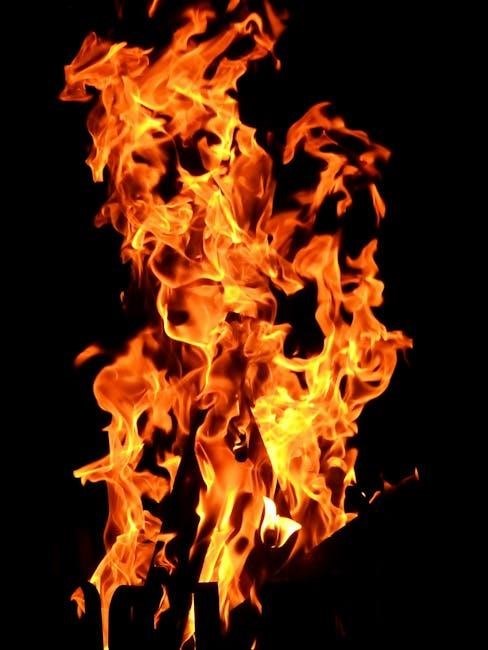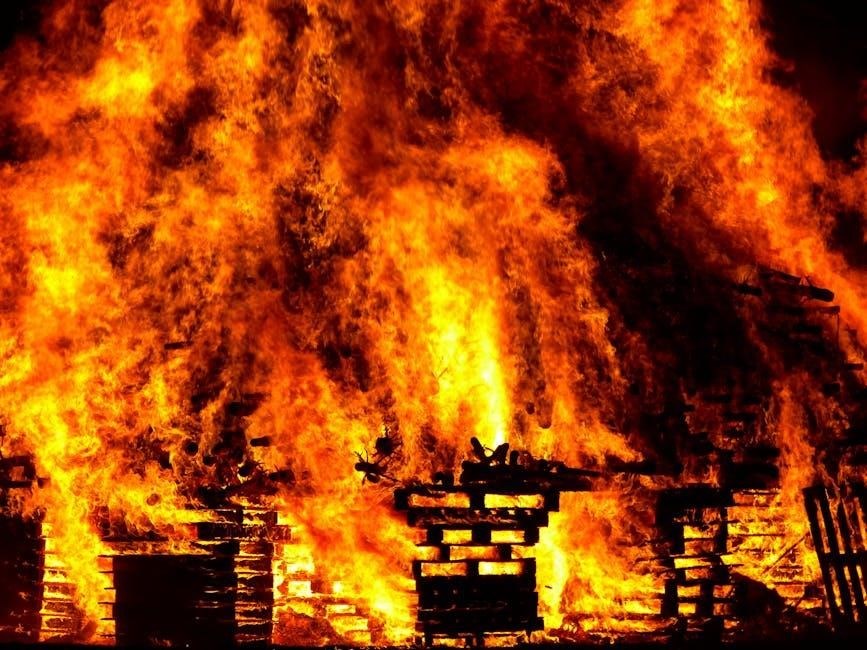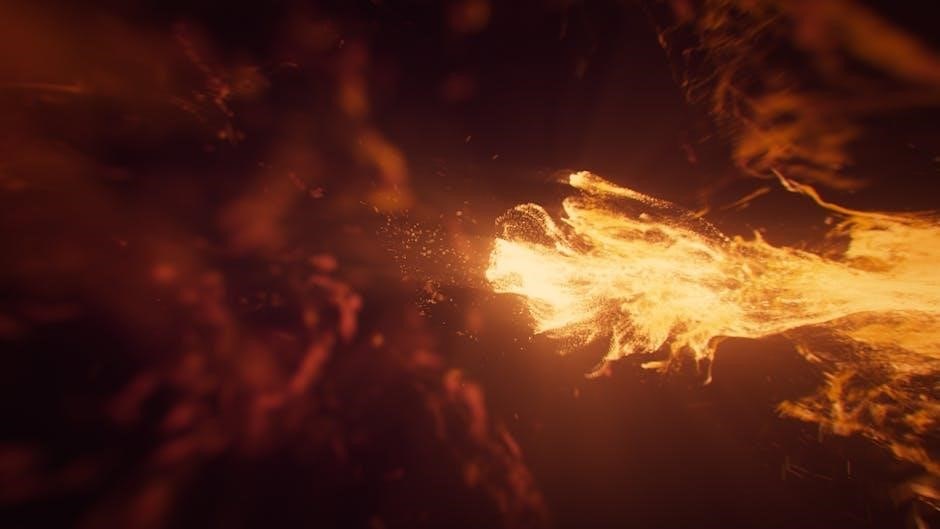inferno dante’s guide to hell
Dante’s Inferno is a timeless masterpiece exploring moral and spiritual themes through a descent into Hell. This guide offers insights into the nine circles, sin punishments, and historical context, blending gameplay tips with literary analysis for a deeper understanding.
Overview of Dante Alighieri’s Inferno

Dante Alighieri’s Inferno is the first part of his epic poem, The Divine Comedy, written in the early 14th century. It follows Dante’s journey through the nine circles of Hell, guided by the Roman poet Virgil. The poem is a masterpiece of Italian literature, blending theology, philosophy, and vivid imagery to depict sin, redemption, and divine justice. Virgil serves as Dante’s moral guide, helping him navigate the underworld and confront the consequences of sin. The Inferno is structured into 34 cantos, each exploring different levels of Hell, where souls are punished according to the severity of their sins. The poem also reflects Dante’s political and religious views, offering a critique of corruption within the Church and society. Inferno’s themes of moral accountability and divine love have made it timeless, inspiring countless adaptations, including modern video games and study guides. Its rich narrative and symbolic depth continue to captivate readers and scholars alike.
Historical Context of the Divine Comedy
The Divine Comedy, including Inferno, was written by Dante Alighieri during the early 14th century, a period marked by political turmoil and religious upheaval. Dante, exiled from his native Florence due to factional conflicts, composed the poem as a reflection of his personal struggles and broader societal issues. The work is deeply rooted in medieval theology, drawing heavily from Catholic doctrine and classical philosophy. Dante’s masterpiece also serves as a critique of the corruption within the Church and the political instability of Italy. The poem’s structure and themes were influenced by the cultural and intellectual movements of the time, including the rise of humanism and the enduring legacy of ancient Roman literature. By blending religious allegory with personal narrative, Dante created a work that not only addressed the spiritual concerns of his era but also transcended time, becoming a cornerstone of world literature. The historical context underscores Dante’s aim to inspire moral and spiritual reform through his vivid depiction of Hell, Purgatory, and Paradise.

The Structure of Hell in Dante’s Inferno
Dante’s Hell is divided into nine concentric circles, each representing escalating severity of sin. Punishments align with the nature of the sin, reflecting moral culpability and divine judgment in an organized hierarchy.

The Nine Circles of Hell
Dante’s Inferno divides Hell into nine circles, each corresponding to a specific type of sin and its severity. The upper circles punish lesser sins like limbo and lust, while deeper circles condemn more egregious offenses such as heresy, violence, deceit, and treachery. The ninth circle, the lowest and most punitive, is reserved for traitors, encased in ice. Each circle reflects the nature of the sin, with punishments mirroring the wrongdoing. This structured hierarchy emphasizes moral culpability, with the deepest layers housing those who betrayed trust and committed the most heinous acts. The nine circles represent a systematic progression of divine judgment, illustrating Dante’s vision of moral accountability and eternal consequences. This framework has become iconic in literature, influencing depictions of Hell in art, games, and popular culture, as seen in modern adaptations like the video game Dante’s Inferno, which draws inspiration from this timeless structure.

Limbo: The First Circle
Limbo, the first circle of Hell, is a realm where the unbaptized and virtuous pagans reside. It is a place of neither punishment nor bliss, characterized by a sense of existential longing. Here, souls like ancient philosophers and moral leaders live in a state of passive existence, deprived of divine grace but not subjected to torment. Dante encounters notable figures such as Aristotle, Plato, and Virgil, his guide, who resides here. Limbo represents the idea that those who lived virtuous lives but lacked baptism are excluded from Heaven, highlighting the theological debate about salvation and faith. The atmosphere is tranquil, with no physical suffering, yet it is filled with the sorrow of unfulfilled potential. This circle serves as an introduction to Dante’s journey, setting the tone for the moral and spiritual exploration that follows. Limbo’s significance lies in its reflection of Dante’s views on morality, faith, and the nature of divine judgment.
Lust: The Second Circle
The second circle of Hell is reserved for those who succumbed to the sin of lust. Here, souls are tossed about by violent winds, symbolizing the uncontrollable nature of their desires during life. Dante encounters famous lovers like Paris and Helen, as well as Tristan and Iseult, whose passionate but doomed relationships exemplify the sin of lust. The winds howl without cease, denying the souls even a moment of peace, mirroring the turmoil of their earthly passions. Dante’s guide, Virgil, explains that these souls are punished for allowing their appetites to dominate their reason. The presence of such iconic figures underscores the universal human struggle with desire. This circle serves as a stark reminder of the consequences of indulging in uncontrolled passion, contrasting with the ideal of divine love. The punishment is both physical and emotional, as the souls are unable to rest or find solace, forever at the mercy of the tempests.

Gluttony: The Third Circle

The third circle of Hell is reserved for the gluttons, who are forced to lie in a foul, slushy mixture that represents the waste of their excessive appetites. The ground is vile, and a foul, icy rain falls constantly, adding to the misery of the damned. These souls are unable to even recognize one another, as their minds are consumed by their own filth. Dante and Virgil encounter a figure named Ciacco, who laments the fate of Florence and predicts its future turmoil. The punishment here reflects the idea that gluttony, like all sins, leads to a form of self-destruction. The souls are stripped of their humanity, reduced to wallowing in the mire they created through their own excess. This circle serves as a stark warning against overindulgence, emphasizing the moral decay that results from prioritizing physical pleasures above all else. The foul conditions and lack of dignity underscore the degradation of the gluttons’ existence.
Greed: The Fourth Circle
The fourth circle of Hell is where the greedy and the prodigal are punished, forced to push heavy weights against each other in a futile labor. These souls are unable to pass one another, symbolizing the selfishness and materialism that consumed their lives. The weight of their sins is literal, as they strain under the burden of their own greed. Dante encounters Plutus, the wolf-like demon of wealth, who embodies the corrupting influence of materialism. The punishment reflects the idea that greed leads to a never-ending struggle, as the damned are trapped in a cycle of pushing and pulling without progress. This circle highlights Dante’s critique of excessive wealth and the moral decay it fosters. The souls here are stripped of their humanity, reduced to mindless labor, unable to escape the consequences of their earthly obsessions. The futility of their efforts underscores the ultimate emptiness of greed and the importance of moderation in life.
Anger: The Fifth Circle
In the fifth circle of Hell, Dante encounters the wrathful, who are forced to dwell in the Stygian Marsh. These souls are consumed by their own anger, manifesting it through violent clashes with one another. The marsh itself is a stagnant and oppressive environment, reflecting the emotional turmoil of those trapped within it. The wrathful are unable to find peace, as their anger continues to fuel their suffering. Dante observes that their rage has become an eternal torment, with no hope of resolution. This circle serves as a stark reminder of the destructive nature of unchecked anger, which alienates individuals from others and themselves. The punishment here is fitting, as the anger that once divided them in life now binds them in eternal conflict. This circle underscores Dante’s vision of Hell as a place where sins are not only punished but also perpetuated in a cycle of misery. The fifth circle is a haunting illustration of the consequences of allowing anger to dominate one’s soul.
Heresy: The Sixth Circle

In Dante’s Inferno, the sixth circle of Hell is reserved for heretics, those who rejected the teachings of the Church and embraced false beliefs. These souls are enclosed in flaming tombs, symbolizing the fiery passion of their misguided convictions; The tombs are sealed, representing the finality of their damnation, as they are deemed beyond redemption. Dante encounters various heretics, including Epicurus and his followers, who denied the existence of an afterlife. The sixth circle reflects the medieval Church’s condemnation of heresy as a grave offense against divine truth. The punishment here emphasizes the enduring consequences of rejecting established religious doctrines. This circle serves as a warning against the dangers of intellectual pride and the refusal to accept spiritual authority. The heretics’ eternal torment in fire underscores the severity of their sin in Dante’s theological framework. The sixth circle is a stark illustration of the medieval Catholic Church’s view on heresy and its repercussions in the afterlife.
Violence: The Seventh Circle
The seventh circle of Hell, as depicted in Dante’s Inferno, is a place of intense suffering for those who turned to violence in life. This circle is divided into three distinct regions: the outer ring, where those who were violent against others are punished; the middle ring, where the violent against themselves are tormented; and the innermost ring, reserved for the violent against God, nature, and art. Dante’s guide, Virgil, leads him through this chaotic landscape, where rivers of boiling blood and fiery rains exacerbate the torment. The souls here are forced to endure physical pain that mirrors the violence they inflicted on others. The seventh circle highlights Dante’s condemnation of violence and its destructive nature. The punishments are designed to reflect the severity of the sins, ensuring that the torments endured are as brutal as the acts committed in life. This circle serves as a grim reminder of the consequences of unchecked aggression and the importance of maintaining peace and harmony.
Deceit: The Eighth Circle
In Dante’s Inferno, the Eighth Circle of Hell, known as Malebolge (“evil ditches”), is a place of torment for those who engaged in deceit and fraud during their lifetimes. This circle is divided into ten ditches, each corresponding to a specific type of fraud, such as pandering, flattery, and counterfeiting. The punishments here are designed to reflect the nature of the sin, often involving physical suffering and humiliation. For example, pimps and seducers are whipped by demons as they run in circles, while counterfeiters are afflicted with a painful, disfiguring disease. The Eighth Circle emphasizes Dante’s condemnation of deceit as a corruption of trust and relationships. The structure of this circle, with its layered ditches, reflects the complexity and depth of fraudulent acts. The punishments grow increasingly severe as Dante and Virgil descend, ultimately leading to the Ninth Circle, where the treacherous are doomed to eternal suffering. This circle serves as a stark reminder of the moral and ethical consequences of deceitful behavior.
Treachery: The Ninth Circle
The Ninth Circle of Hell, known as Cocytus, is the final and most severe realm in Dante’s Inferno, reserved for those guilty of treachery. This circle is a frozen lake where the damned are trapped in ice, their bodies paralyzed and unable to move or escape. The depth of their betrayal determines the severity of their entombment, with the most treacherous being completely submerged in the ice. The frozen landscape reflects the cold, unfeeling nature of their sins. At the very center of this circle is Lucifer, the fallen angel, who churns the ice with his massive wings, perpetuating the torment. Dante and Virgil must navigate this frozen expanse, confronting infamous traitors like Judas Iscariot and Brutus along the way. The Ninth Circle represents the ultimate betrayal of trust and the irreversible consequences of such actions. It is here that Dante’s journey through Hell reaches its climax, preparing him for his ascent toward redemption.